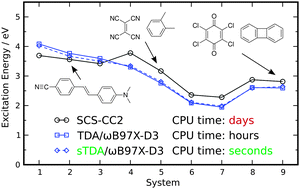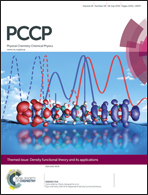Excited states using the simplified Tamm–Dancoff-Approach for range-separated hybrid density functionals: development and application†
Abstract
The recently introduced sTDA methodology [S. Grimme, J. Chem. Phys., 2013, 138, 244104] to compute excitation spectra of huge molecular systems is extended to range-separated hybrid (RSH) density functionals. The three empirical parameters of the method which describe a screened two-electron interaction are obtained for some common RSH functionals (ωB97 family, CAM-B3LYP, LC-BLYP) from a fit to theoretical SCS-CC2 reference vertical excitation energies for a set of small to medium-sized chromophores. The method is cross-validated on a set of inter- and intramolecular charge transfer states and a set composed of typical valence transitions. Overall small deviations from reference data of only about 0.2–0.4 eV are found with best performance for CAM-B3LYP and ωB97X-D3. To demonstrate versatility and robustness of the new methodology, applications (the UV/Vis spectrum of the pyridine polymer and the ECD spectrum of (P)-[11]helicene) and frequently used charge transfer examples are discussed. In one case, 11 000+ excited electronic states of a system containing 330 atoms were calculated. We show that the asymptotically correct sTDA–RSH combination yields results often superior to those based on global hybrids and that it opens up new possibilities for the computation of excited states in materials science and bio-molecular systems.

- This article is part of the themed collection: Density functional theory and its applications

 Please wait while we load your content...
Please wait while we load your content...